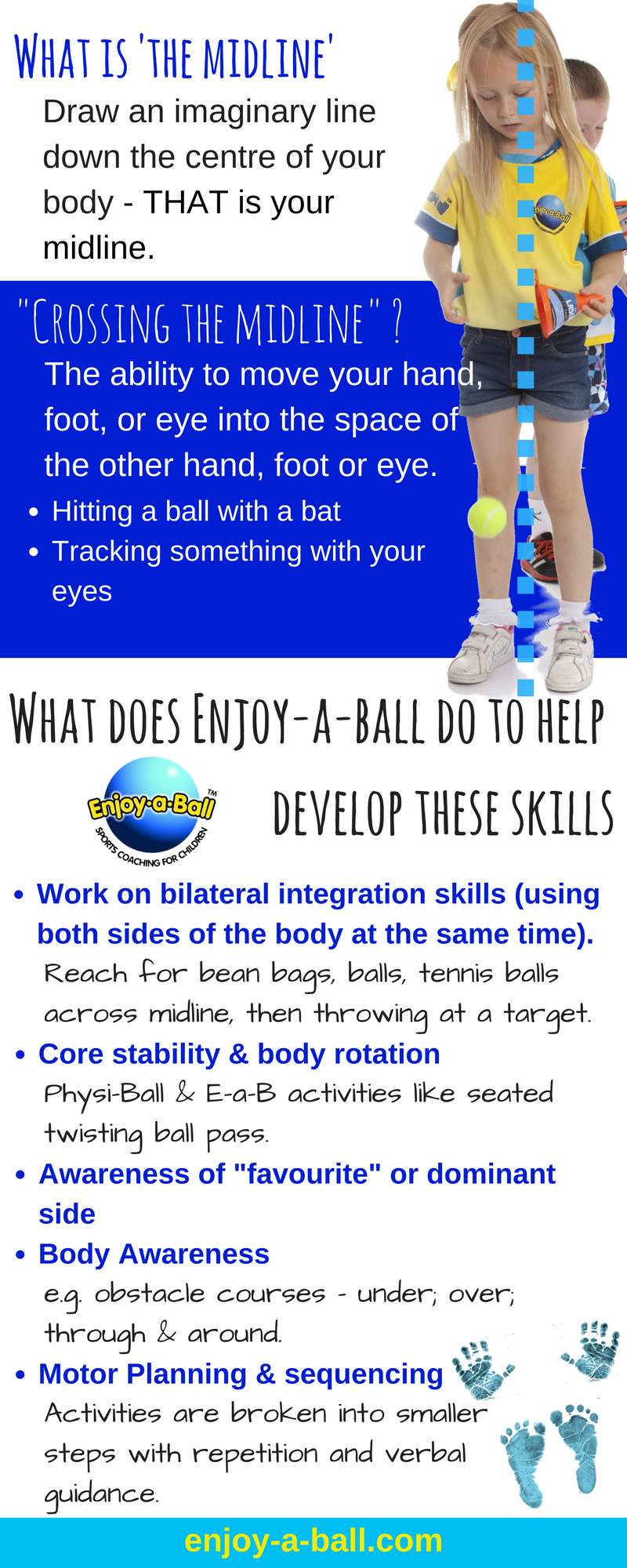
If you have children you will be aware of gross motor skill development – Gross motor skills involve movement of the large muscles in arms, legs, and torso and gross motor activities include walking, running, skipping, jumping, throwing, climbing and many others.
If you follow child development or occupational therapy sites on the internet or social media (or read up on your child’s Enjoy-a-Ball class) you will most definitely have come across the concept of “crossing the midline”.
The ability to cross the midline (picture an invisible line running down the centre of your body) indicates that both sides of the brain are working efficiently together and it is hugely relevant to a child’s reading, writing, motor planning, and consequently, gross and fine motor coordination.
A lot of the activities we do at Physi-Ball and Enjoy-a-Ball develop skills that will help a toddler and young child with bilateral integration. Bilateral integration, in a nutshell, refers to the ability to smoothly perform actions using both sides of the body simultaneously. Successful gross motor movements are a result of bilateral integration.
So, if crossing the midline is the 4th stage of bilateral integration – what are the other stages?
Symmetrical bilateral integration involves both sides of the body working in mirror-image unison, where the actions on one side of the body mirror the actions performed on the other side. An example of this is clapping hands or using a roller to roll out play dough.
Reciprocal bilateral integration involves moving both sides of the body at the same time in opposite motions. Reciprocal movements are also called alternating movements – they are actions where first one hand or leg and then the other carries out the same movement in a rhythmical way. A classic example is pedalling a bicycle.
Asymmetrical bilateral integration involves each side of the body acting in a different way to complete a single specific task. For example, one foot may kick a ball as the other foot plants on the ground and balances the body. Or: one hand holds the paper whilst the other hand handles the scissors to cut the paper – both hands are working together in a coordinated way, but one is leading and the other is supporting.
The “midline” is the imaginary line down the center of your body from the top of your head to your toes). Crossing the midline involves instinctively reaching across your body to complete an activity.
Strong gross motor skills depend, in a large part, on strong muscles. Muscles gain strength through repeated activity and practice, which is why we use a structured programme to make sure your child gets the opportunities to learn and practice skills and we encourage them (with your participation) to work on those skills at home. The progression within the Enjoy-a-Ball programme can be illustrated as follows:
– we roll a large ball towards your child while they stand in place. They can stop it with their hands or feet and roll it back with hands or feet.
– we roll a ball towards them and instruct them to kick it back without stopping it first. As they gain confidence and get comfortable with this activity, we have them walk (and later run) towards the ball as it rolls towards them. This type of activity involves advanced asymmetrical bilateral integration as well as coordination.
Most of all – have fun and ENJOY being active.
No comments yet